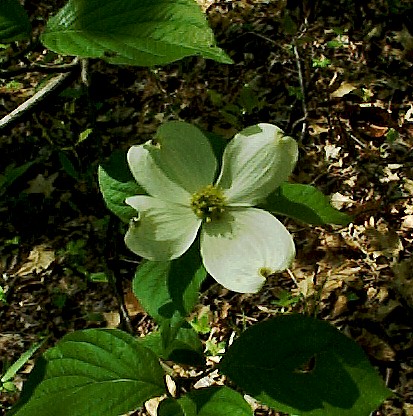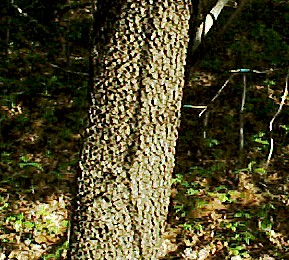

Small tree to 8 m (20 ft) tall and 20 cm (8 in) in diameter. Bark dark red-brown, fissured into small blocks. Twigs thin, greenish to reddish, soon becoming glabrous, with rings at nodes. Leaf buds dark reddish or purple, somewhat egg-shaped. Flower buds large, flattened longitudinally, stalked, developing in Fall and conspicuous through the Winter. Leaves opposite, elliptical, 6-13 cm (2.4-5.1 in) long and 4-6 cm (1.6-2.4 in) wide, margins usually slighty undulate and finely serrate, with several prominent curved side veins, green and glabrous above, whitish and finely hairy below, usually turning bright red or purplish in Fall. Flowers small, numerous, crowded in a head about 2 cm (0.8 in) in diameter, blooming in early spring. The flower head is surrounded by 4 large white (rarely pink) bracts which resemble petals, and which have a usually dark notch at the tip. Fruits shiny red drupes about 10-15 mm (0.4-0.6 in) long, crowded at the end of a long stalk, ripening in Fall.
Distribution: About the eastern half of the U. S. except the northern border.
Habitat: Forest understory and old fields.
NWI status: FACU
Comment: Flowering dogwood is widely planted as an ornamental for its large showy "flowers" in the early Spring and the colorful fruits and foliage in late Fall. The pink form, which is rare in the wild, is common in cultivation. Cornus is derived from the Latin word for horn, referring to the hard wood; florida refers to the large petal-like bracts surrounding the flower head.
Distribution in Oklahoma: 
BACK
NEXT
RETURN TO INDEX
Last update: 9/9/99
 Go to Oklahoma Biological Survey Home Page
Go to Oklahoma Biological Survey Home Page
 Disclaimer
Disclaimer